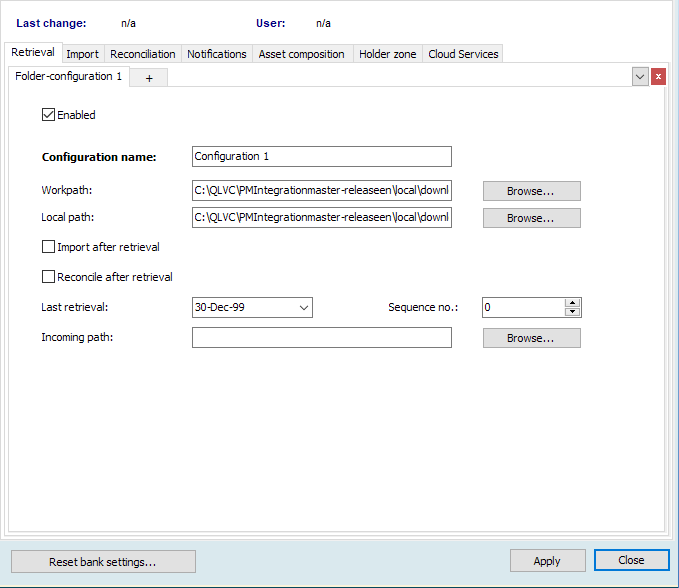"Retrieval" tab

Specify paths, folders and behaviour for the retrieval of each interface: You can create and save various configurations that you can quickly enable or disable later.
The tab provides the following configuration options:
Element | Description |
|---|---|
Enabled | Select this checkbox to apply the current configuration to the retrieval. If you have created several configurations, you can enable or disable them individually. |
Configuration name | Enter the description of the configuration in this input field. This description is used for the preview of the paths as well as in the log. |
Working path | Specify the working path for the retrieval. In addition to entering the path manually, you can also click the "Browse..." button to select the necessary path for the "Work" folder. In the "Work" folder, the retrieved files of your bank are stored unchanged. |
Local path | Specify the local path for the retrieval. In addition to entering the path manually, you can also click the "Browse..." button to select the required path for the "Local" folder. In the "Local" folder, the retrieved files are daily copied as zip archives from the "Work" folder (described above) and can be imported from there. |
Import after retrieval | Select this checkbox if you want to start the import after the retrieval is finished. |
Reconcile after retrieval | Select this checkbox if you want to start a reconciliation after the retrieval is finished. |
Last retrieval | The date of the last retrieval. You can enter the date manually or pick it from the calendar. |
| Sequence number | (Only for some interfaces) |
Retrieval from folder | |
Element | Description |
Incoming path | Specify the incoming path for the data to be retrieved from a folder. In addition to entering the path manually, you can also click the "Browse..." button to select the required incoming path. |
HTTPS retrieval | |
Element | Description |
HTTPS address | Enter the date for the prices to be retrieved. |
User name | Enter the corresponding user name. |
Password | Enter your password. |
FTP retrieval | |
Element | Description |
FTP server | Enter the FTP server for the data to be retrieved. |
User name | Enter the corresponding user name. |
Password | Enter your password. |
Port | Enter the correct port for the retrieval. |
Remote path | Enter the remote path for the FTP retrieval. |
SFTP retrieval | |
Element | Description |
SFTP server | Enter the SFTP server for the data to be retrieved. |
User name | Enter the corresponding user name. |
Password | Enter your password. |
Port | Enter the correct port for the retrieval. |
Remote path | Enter the remote path for the SFTP retrieval. |
| Timeout | Enter the number of seconds for the timeout. |
| RSA key | Select the appropriate file with the RSA key here via the corresponding "Load..." button. |
| Deep download (through all subfolders) | Select this checkbox if you want to use the "deep" download. Selecting this feature will allow you to download all files from subfolders as well. |
| File pattern | If necessary, enter a regular expression here to filter the files to be downloaded. |
Enable special date detection | Select this checkbox for date recognition. Selecting explicit date patterns allows only newer files to be downloaded if the server does not explicitly mark downloaded files as read or removes them. Then enter the corresponding date patterns in the input fields below. |
| Date pattern (from) | Enter the regular expression here to extract the date from the file names. |
| Date pattern (to) | Enter the regular expression here to reformat the date to the required target format. Currently, "YYYYMMDD", "YYYYMMDDHHNN" or "YYYYMMDDHHNNSS" are possible as target formats. |
| "Configure SFTP retrieval" area | Here you can decide what to do with the retrieved data by selecting the corresponding option:
To delete or archive the retrieved data after processing is complete, you need the appropriate write permissions on the SFTP server. Once you have made and saved your settings, you can use the "Check write permissions" button to check whether you have the necessary write permissions on the SFTP server to use the advanced options. After the check was completed, the result appears in a corresponding message window. Only if the write permissions are available, the two options "Retrieve data and then delete" and "Retrieve data and then archive" become active and can be selected. |
In addition, there can be further setting options for your PSI Transaction Data on this tab, for example, certificate with password and selection of data packages.
